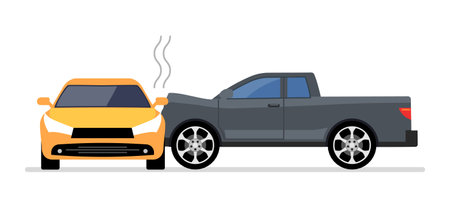Understanding Common Car Emergencies
When it comes to driving in the United States, emergencies like brake failures and tire blowouts aren’t just rare occurrences—they’re real risks that every driver should be prepared for. Getting familiar with these common car emergencies is a vital first step toward keeping yourself, your passengers, and even other road users safe. Brake failures can happen suddenly due to worn-out components or unexpected mechanical issues, while tire blowouts may result from hitting debris or driving on underinflated tires. Knowing how to recognize the warning signs and respond quickly is crucial not only for personal safety but also for supporting a culture of responsibility and sustainability on the road. By understanding what can go wrong and why, you’ll be better equipped to minimize harm and make eco-friendly choices during stressful situations.
2. Staying Calm and Focused
When you’re faced with a sudden brake failure or a tire blowout on an American highway, your first and most critical response should be to remain calm. Panicking can lead to rash decisions that may escalate the emergency. Whether you’re driving through the urban streets of Los Angeles or cruising down a Midwest interstate, keeping your cool is the foundation for effective crisis management behind the wheel.
Clear-headed decision-making allows you to assess your situation quickly and respond appropriately. Instead of slamming on the brakes or jerking the steering wheel—common reactions during a panic—you’ll be able to take calculated actions that prioritize safety for yourself and others on the road.
| Situation | Stay Calm Response | Panic Response |
|---|---|---|
| Brake Failure | Downshift, use emergency brake, signal and steer to safety | Pump brakes wildly, swerve uncontrollably, freeze up |
| Tire Blowout | Grip wheel firmly, ease off gas, steer straight, pull over safely | Slam brakes, oversteer, lose control |
If you find yourself in an automotive emergency, remember that your ability to stay composed not only helps you execute lifesaving maneuvers but also keeps those around you safe. In moments of crisis, Americans value quick thinking and resilience—qualities that start with managing your own mindset before anything else. By practicing mindfulness and focusing on what you can control, you set yourself up for success in navigating any road emergency.

3. Responding to Brake Failure
If you ever find yourself behind the wheel and your brakes suddenly stop working, staying calm is your most powerful tool. Panic can cloud your judgment, but a clear mind helps you take swift, effective action. Here’s how to respond step-by-step:
Step 1: Stay Calm and Assess
First, take a deep breath and keep your hands firmly on the steering wheel. Avoid sudden movements that could make the situation worse. Try to gauge your surroundings—look for open spaces or safe shoulders where you might steer the vehicle if necessary.
Step 2: Downshift Gradually
If you drive an automatic, slowly ease off the accelerator and shift to a lower gear (like “L” or “2”). For manual transmissions, carefully downshift one gear at a time. This uses engine braking to slow your car in a more sustainable, controlled way, reducing your reliance on potentially failing brakes.
Step 3: Use Emergency Brake Wisely
Gently engage the emergency brake (also called parking brake). Avoid pulling it abruptly—it should be applied gradually to prevent skidding or losing control. This secondary system works independently of your main brakes and can help bring you to a stop.
Step 4: Signal for Help and Warn Others
Turn on your hazard lights right away to alert other drivers that something is wrong. If possible, honk your horn intermittently to catch attention, especially if traffic is heavy. This not only signals distress but also encourages others to give you extra space on the road.
Step 5: Safely Steer Off the Road
Look for a safe spot like an emergency lane, wide shoulder, or grassy area away from traffic. Steer smoothly towards it as your vehicle slows down. Once stopped, keep your hazards on and call for roadside assistance.
Sustainable Safety First
Remember, handling brake failure sustainably means minimizing risk to yourself, other drivers, and the environment by remaining calm, using natural deceleration methods, and signaling clearly. By following these steps, you can manage this emergency effectively without putting yourself or others in unnecessary danger.
4. Handling a Tire Blowout
Experiencing a tire blowout can be alarming, but staying calm and following best practices helps you maintain control and minimize risk to yourself, others, and the environment. Here’s how to manage a tire blowout effectively while keeping sustainability in mind:
Stay Calm and Maintain Control
If you hear a loud pop or feel your vehicle suddenly pull to one side, grip the steering wheel firmly with both hands. Avoid slamming on the brakes; instead, gently ease off the accelerator to gradually reduce your speed.
Safely Guide Your Vehicle
Keep your vehicle moving straight as much as possible. Signal and carefully steer toward the shoulder or a safe area away from traffic. Once stopped, turn on your hazard lights to alert other drivers of your situation.
Minimize Environmental Impact
Whenever possible, pull over onto paved surfaces rather than grass or soft shoulders to avoid damaging local ecosystems. Stay aware of your surroundings and avoid blocking bike lanes or pedestrian paths.
Quick Reference: What To Do During a Tire Blowout
| Action | Purpose | Sustainability Tip |
|---|---|---|
| Hold steering wheel firmly | Maintain control of vehicle | Avoid sudden movements to reduce risk for all road users |
| Ease off accelerator gently | Prevent loss of control | Smooth deceleration reduces emissions from abrupt stops |
| Steer gradually to safe area | Avoid collisions and further tire damage | Select hard surfaces for stopping to protect natural areas |
| Turn on hazard lights | Warn other drivers of emergency situation | Keeps everyone informed and improves safety for all |
| Call for roadside assistance if needed | Ensure professional help arrives quickly | Tire recycling programs can responsibly dispose of damaged tires |
After the Incident: Sustainable Steps Forward
If your tire is severely damaged, opt for repair or replacement at certified green auto shops that recycle old tires. Choosing eco-friendly tire brands made from sustainable materials also reduces future environmental impact.
5. Utilizing Emergency Resources and Tools
When facing unexpected events like brake failures or tire blowouts, having the right emergency resources on hand can make all the difference. American drivers are known for their long road trips and cross-country adventures, making preparation a vital part of local driving culture. Keeping a well-stocked emergency kit in your vehicle isn’t just smart—it’s essential for personal safety and peace of mind.
Must-Have Tools for Every Vehicle
Your car’s emergency kit should include basic tools such as a flashlight with extra batteries, jumper cables, reflective warning triangles or flares, a multipurpose tool, and a tire pressure gauge. For brake or tire-related incidents specifically, carrying a portable air compressor, a spare tire (in good condition), and a lug wrench is crucial. Don’t forget a sturdy jack to safely lift your vehicle if you need to change a tire on the roadside.
First Aid and Eco-Friendly Supplies
No emergency kit is complete without first aid essentials: bandages, antiseptic wipes, gloves, and over-the-counter pain relievers. To align with growing green energy trends, consider adding biodegradable wipes and reusable water bottles to your kit. If you’re in areas prone to extreme weather, pack thermal blankets and eco-friendly hand warmers—these support both safety and sustainability.
Green Roadside Assistance Options
Traditional towing services are helpful but may not always prioritize environmental responsibility. Today, many American drivers are choosing green roadside assistance providers who utilize electric service vehicles or offer carbon-neutral options. These services help minimize the environmental impact while delivering timely help for issues like flat tires or failed brakes. Research local providers before your next trip to ensure you have access to sustainable support when it matters most.
Cultural Habits That Enhance Safety
In the U.S., it’s common practice to share emergency resource tips within communities—whether through online forums, neighborhood groups, or during driver’s education classes. Staying informed about the latest tools and green solutions empowers drivers to respond effectively and responsibly during emergencies. By integrating these habits into your routine, you can confidently tackle unexpected situations while championing sustainability on the road.
6. Preventive Maintenance and Sustainable Driving Habits
One of the most effective ways to handle emergencies like brake failures or tire blowouts is to prevent them from happening in the first place. Proactive vehicle maintenance and eco-conscious driving not only keep you safer on the road, but also help reduce your carbon footprint.
Regular Vehicle Checkups Matter
Routine inspections are key. Schedule regular brake checks, monitor your tire pressure, and look for signs of wear or damage. Make sure your fluids are topped off and that all lights and signals function properly. Not only do these habits extend your car’s lifespan, but they also minimize the risk of sudden breakdowns or dangerous situations.
Eco-Friendly Driving Strategies
Adopting sustainable driving practices benefits both you and the environment. Accelerate smoothly, avoid hard braking, and maintain steady speeds to decrease wear on your brakes and tires. Consider carpooling when possible, combining errands into one trip, and using cruise control on highways to save fuel. These small changes can make a big impact over time.
The Road Ahead: A Greener, Safer Journey
By prioritizing preventive maintenance and embracing green driving habits, you contribute to a safer community while supporting America’s commitment to sustainability. Remember, it’s not just about avoiding emergencies—its about creating a future where every journey is safer for you, your passengers, and the planet.


